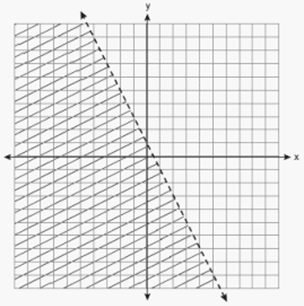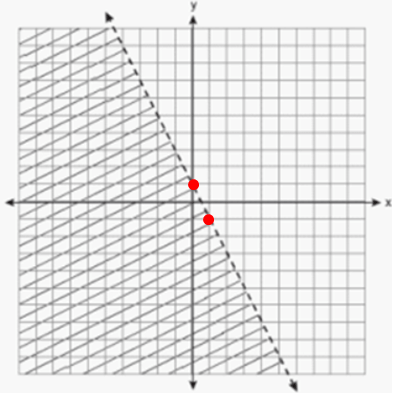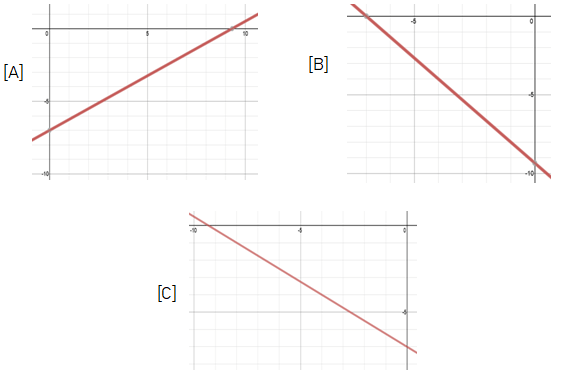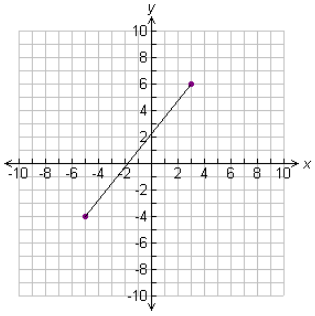EQUATIONS AND LINEAR FUNCTIONS PRACTICE EOC
Problem 1 :
If 8x = -4(x + 3), then x = ?
A) -1 B) 1 C) 3/4 D) 1/4
Solution :
8x = -4(x + 3)
8x = -4x - 12
8x + 4x = -12
12x = -12
x = -12/12
x = -1
Problem 2 :
Solve for x :
9x2 - c = d
Solution :
9x2 - c = d
Adding c on both sides
9x2 = d + c
Dividing by 9 on both sides.
x2 = (d + c)/9
x = √[(d + c)/9]
x = √(d + c)/3
So, option A is correct.
Problem 3 :
Which inequality is represented by the graph below.

Solution :

Since it is the falling line, rise = 2 and run = 1
Slope = rise / run = 2
y-intercept = 1
y = 2x + 1
Choosing a point below the line (-1, 0),
0 = 2(-1) + 1
0 = -2 + 1
0 = -1
The line given is a dotted line, we should use dotted line.
y > 2x + 1
Problem 4 :
Jared can run 520 yards in one minute. How fast does he run in feet per second?
A) 12 B) 26 C) 1560 D) 16
Solution :
He can run 520 yards in one minute
3 ft = 1 yard
520 yard = 520(3)
= 1560 ft
In one minute, he can run 1560 ft.
1 minute = 60 seconds
60 second = 1560 ft
1 second = 1560/60
1 second = 26 ft
Problem 5 :
There are three consecutive integers such that the sum of the two smallest integers is 17 less than three times the largest. What is the smallest integer?
A) 5 B) 7 C) 12 D) 6
Solution :
Let x, x + 1 and x + 2 be three consecutive integers.
x + x + 1 = 3(x + 2) - 17
2x + 1 = 3x + 6 - 17
2x - 3x = -17 + 6 - 1
-x = -12
x = 12
So, the smallest integer is 12.
Problem 6 :
Which expression is equivalent
Solution :
Problem 7 :
Which graph below displays the equation 3x - 4y = 28

Solution :
3x - 4y = 28
Finding x and y -intercepts, we get
|
x-intercept : Put y = 0 3x - 4(0) = 28 3x = 28 x = 28/3 x = 9.3 |
y-intercept : Put x = 0 3(0) - 4y = 28 -4y = 28 y = -28/4 y = -7 |
In option A, the line has x-intercept is positive and y-intercept is negative.
So, option A is correct.
Problem 8 :
Compare the slope of f(x) = -2x + 3 and the slope of the chart of g(x) below.

What is the positive difference between the slopes of f(x) and g(x)?
A) 1 B) 5 C) 8 D) 17
Solution :
Slope of g(x) from the table,
(2, -8) and (4, -2)
Slope (m) = [-2 - (-8)] / (4 - 2)
= (-2 + 8) / 2
= 6/2
= 3
f(x) = -2x + 3
Comparing with y = mx + b
Slope of f(x) = -2, slope of g(x) = 3. slope of g(x) is greater.
f(x) - g(x) = -2 - 3 ==> -5
Problem 9 :
Gregory teaches martial arts. He charges a one-time processing fee of $5.00 and the cost of the classes is shown below. Let x represent the number of classes and y represent the cost of classes.

Based on this information, what will it cost to take 10 classes?
A) $123 B) $128 C) $118 D) $153
Solution :
(1, 15) and (2, 27)
Rate of change = (27 - 15) / (2 - 1)
= 12/1
= 12
y-intercept (initial cost) = 5
y = 12x + 5
Cost for 10 classes :
y = 12(10) + 5
y = 120 + 5
y = 125
Problem 10 :
Jerami is going to deposit an equal amount of money into a checking account each month until he has saved $2,000. The amount of money, y, in the account after x months can be modeled by the equation y = 35x + 250.
What does the slope of the graph of the equation represent?
[A] The amount of money deposited monthly
[B] The amount of money originally in the account
[C] The number of months it would take to earn $250
[D] The number of months it would take to reach $2,000
Solution :
Slope means rate of change, the amount he saves monthly. So, option A is correct.
Problem 11 :
Find the range of the function represented in the graph.

A) The range consists of values from -5 to 3.
B) The range consists of values from -4 to 6.
C) The range consists of values from -5 to 6.
D) The range consists of values from -4 to 3.
Solution :
By observing the graph, the graph spread vertically in between -5 to 3.
Problem 12 :
Which equation represents the line passing through the points (3, 2) and (–9, 6)?
A) x – 3y = 9 B) x + 3y = 9
C) 3x – y = -9 D) 3x + y = 9
Solution :
(3, 2) and (–9, 6)
Slope (m) = (6 - 2) / (-9 - 3)
= -4/12
= -1/3
Equation of the line :
y - y1 = m(x - x1)
y - 2 = (-1/3) (x - 3)
3(y - 2) = -1(x - 3)
3y - 6 = -x + 3
x + 3y = 3 + 6
x + 3y = 9
Problem 13 :
Which of the following represents the linear equation
3(x + 2) = 12 – 2y
in standard form?
A) y = -3/2x + 3 B) y = 3/2x - 3 C) 3x – 2y = 10
D) 3x + 2y = 6
Solution :
3(x + 2) = 12 – 2y
3x + 6 = 12 - 2y
3x + 2y = 12 - 6
3x + 2y =6
2y = 6 - 3x
y = -3x/2 + 6/2
y = -3x/2 + 3
Recent Articles
-
Finding Range of Values Inequality Problems
May 21, 24 08:51 PM
Finding Range of Values Inequality Problems -
Solving Two Step Inequality Word Problems
May 21, 24 08:51 AM
Solving Two Step Inequality Word Problems -
Exponential Function Context and Data Modeling
May 20, 24 10:45 PM
Exponential Function Context and Data Modeling